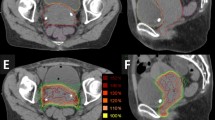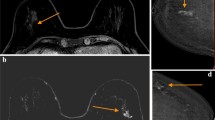Abstract
Objectives
To investigate the prognostic value of diffusion-weighted imaging (DWI) in predicting clinical outcome in patients with cervical cancer after concurrent chemoradiotherapy (CCRT).
Methods
We enrolled 124 cervical cancer patients who received definitive CCRT and underwent 3 T-MRI before and 1 month after initiating treatment. The mean apparent diffusion coefficient (ADC) value was measured on the tumor and the changes in ADC percentage (ΔADCmean) between the two time points were calculated. The Cox proportion hazard model was used to evaluate the associations between imaging or clinical variables and progression-free survival (PFS), cancer-specific survival (CSS), and overall survival (OS).
Results
In multivariate analysis, ΔADCmean was the only independent predictor of PFS (hazard ratio [HR] = 0.2379, p = 0.005), CSS (HR = 0.310, p = 0.024), and OS (HR = 0.217, p = 0.002). Squamous cell carcinoma antigen, histology, and pretreatment tumor size were significantly independent predictors of PFS. Tumor size response was significantly independent predictor of CSS and OS. Using the cutoff values of ΔADCmean, the PFS was significantly lower for ΔADCmean < 27.8% (p = 0.001). The CSS and OS were significantly lower for ΔADCmean < 16.1% (p = 0.002 and p < 0.001, respectively).
Conclusion
The percentage change in tumor ADC may be a useful predictor of disease progression and survival in patients with cervical cancer treated with CCRT.
Key Points
• DWI is widely used as a potential marker of tumor viability.
• Percentage change in tumor ADC (ΔADC mean ) was an independent marker of PFS, CSS, and OS.
• Survival was better in patients with ≥ ΔADC mean cutoff value than with < the cutoff value.



Similar content being viewed by others
Abbreviations
- ADC:
-
Apparent diffusion coefficient
- CCRT:
-
Concurrent chemoradiotherapy
- CI:
-
Confidence interval
- CSS:
-
Cancer-specific survival
- DWI:
-
Diffusion-weighted imaging
- EBRT:
-
External-beam radiotherapy
- FIGO:
-
International Federation of Gynecology and Obstetrics
- HR:
-
Hazard ratio
- ICC:
-
Intraclass correlation coefficient
- ICR:
-
Intracavitary brachytherapy
- LN:
-
Lymph node
- MRI:
-
Magnetic resonance imaging
- OS:
-
Overall survival
- PFS:
-
Progression-free survival
- ROI:
-
Region of interest
- SCC:
-
Squamous cell carcinoma
- T2WI:
-
T2-weighted imaging
- THRIVE:
-
T1-weighted high-resolution isotropic volume examination
- ΔADCmean :
-
Percentage change of mean ADC between two time points
References
Marth C, Landoni F, Mahner S et al (2017) Cervical cancer: ESMO clinical practice guidelines for diagnosis, treatment and follow-up. Ann Oncol 28:iv72–iv83
Friedlander M, Grogan M (2002) Guidelines for the treatment of recurrent and metastatic cervical cancer. Oncologist 7:342–347
Rose PG, Bundy BN, Watkins EB et al (1999) Concurrent cisplatin-based radiotherapy and chemotherapy for locally advanced cervical cancer. N Engl J Med 340:1144–1153
Eifel PJ, Winter K, Morris M et al (2004) Pelvic irradiation with concurrent chemotherapy versus pelvic and para-aortic irradiation for high-risk cervical cancer: an update of radiation therapy oncology group trial (RTOG) 90-01. J Clin Oncol 22:872–880
Schwarz JK, Siegel BA, Dehdashti F, Grigsby PW (2007) Association of posttherapy positron emission tomography with tumor response and survival in cervical carcinoma. JAMA 298:2289–2295
Hamstra DA, Rehemtulla A, Ross BD (2007) Diffusion magnetic resonance imaging: a biomarker for treatment response in oncology. J Clin Oncol 25:4104–4109
Park JJ, Kim CK, Park BK (2016) Prediction of disease progression following concurrent chemoradiotherapy for uterine cervical cancer: value of post-treatment diffusion-weighted imaging. Eur Radiol 26:3272–3279
Makino H, Kato H, Furui T, Morishige K, Kanematsu M (2014) Predictive value of diffusion-weighted magnetic resonance imaging during chemoradiotherapy for uterine cervical cancer. J Obstet Gynaecol Res 40:1098–1104
Harry VN, Semple SI, Gilbert FJ, Parkin DE (2008) Diffusion-weighted magnetic resonance imaging in the early detection of response to chemoradiation in cervical cancer. Gynecol Oncol 111:213–220
Haack S, Tanderup K, Kallehauge JF et al (2015) Diffusion-weighted magnetic resonance imaging during radiotherapy of locally advanced cervical cancer--treatment response assessment using different segmentation methods. Acta Oncol 54:1535–1542
Onal C, Erbay G, Guler OC (2016) Treatment response evaluation using the mean apparent diffusion coefficient in cervical cancer patients treated with definitive chemoradiotherapy. J Magn Reson Imaging 44:1010–1019
Park JJ, Kim CK, Park BK (2016) Prognostic value of diffusion-weighted magnetic resonance imaging and (18)F-fluorodeoxyglucose-positron emission tomography/computed tomography after concurrent chemoradiotherapy in uterine cervical cancer. Radiother Oncol 120:507–511
Nam H, Park W, Huh SJ et al (2007) The prognostic significance of tumor volume regression during radiotherapy and concurrent chemoradiotherapy for cervical cancer using MRI. Gynecol Oncol 107:320–325
Yamanoi K, Matsumura N, Kido A et al (2013) A novel diagnostic criterion for lymph node metastasis in cervical cancer using multi-detector computed tomography. Gynecol Oncol 131:701–707
Mohler J, Bahnson RR, Boston B et al (2010) NCCN clinical practice guidelines in oncology: prostate cancer. J Natl Compr Canc Netw 8:162–200
Ho JC, Allen PK, Bhosale PR et al (2017) Diffusion-weighted magnetic resonance imaging as a predictor of outcome in cervical cancer after chemoradiation. Int J Radiat Oncol Biol Phys 97:546–553
Bae JM, Kim CK, Park JJ, Park BK (2016) Can diffusion-weighted magnetic resonance imaging predict tumor recurrence of uterine cervical cancer after concurrent chemoradiotherapy? Abdom Radiol (NY) 41:1604–1610
Park JJ, Kim CK, Park SY et al (2014) Assessment of early response to concurrent chemoradiotherapy in cervical cancer: value of diffusion-weighted and dynamic contrast-enhanced MR imaging. Magn Reson Imaging 32:993–1000
Himoto Y, Fujimoto K, Kido A et al (2015) Pretreatment mean apparent diffusion coefficient is significantly correlated with event-free survival in patients with International Federation of Gynecology and Obstetrics stage Ib to IIIb cervical cancer. Int J Gynecol Cancer 25:1079–1085
Gladwish A, Milosevic M, Fyles A et al (2016) Association of apparent diffusion coefficient with disease recurrence in patients with locally advanced cervical cancer treated with radical chemotherapy and radiation therapy. Radiology 279:158–166
Karlsson J, Dreifaldt AC, Mordhorst LB, Sorbe B (2017) Differences in outcome for cervical cancer patients treated with or without brachytherapy. Brachytherapy 16:133–140
Sturdza A, Pötter R, Fokdal LU et al (2016) Image guided brachytherapy in locally advanced cervical cancer: improved pelvic control and survival in RetroEMBRACE, a multicenter cohort study. Radiother Oncol 120:428–433
Moore KN, Java JJ, Slaughter KN et al (2016) Is age a prognostic biomarker for survival among women with locally advanced cervical cancer treated with chemoradiation? An NRG Oncology/Gynecologic Oncology Group ancillary data analysis. Gynecol Oncol 143:294–301
Hong JH, Chen MS, Lin FJ, Tang SG (1992) Prognostic assessment of tumor regression after external irradiation for cervical cancer. Int J Radiat Oncol Biol Phys 22:913–917
Xue H, Ren C, Yang J et al (2014) Histogram analysis of apparent diffusion coefficient for the assessment of local aggressiveness of cervical cancer. Arch Gynecol Obstet 290:341–348
Winfield JM, Orton MR, Collins DJ et al (2017) Separation of type and grade in cervical tumours using non-mono-exponential models of diffusion-weighted MRI. Eur Radiol 27:627–636
Liu Y, Sun H, Bai R, Ye Z (2015) Time-window of early detection of response to concurrent chemoradiation in cervical cancer by using diffusion-weighted MR imaging: a pilot study. Radiat Oncol 10:185
Gouy S, Morice P, Narducci F et al (2013) Prospective multicenter study evaluating the survival of patients with locally advanced cervical cancer undergoing laparoscopic para-aortic lymphadenectomy before chemoradiotherapy in the era of positron emission tomography imaging. J Clin Oncol 31:3026–3033
Acknowledgements
We thank Hye Seung Kim, MS, and Insuk Sohn, PhD, of the Statistics and Data Center, Samsung Medical Center, for statistical assistance.
Funding
This study was supported by the Basic Science Research Program through the National Research Foundation of Korea (NRF) funded by the Ministry of Education (NRF-2017R1A2B4006020).
Author information
Authors and Affiliations
Corresponding author
Ethics declarations
Guarantor
The scientific guarantor of this publication is Chan Kyo Kim.
Conflict of interest
The authors of this manuscript declare no relationships with any companies, whose products or services may be related to the subject matter of the article.
Statistics and biometry
Hye Seung Kim, MD and Insuk Sohn, PhD kindly provided statistical advice for this manuscript.
Informed consent
Written informed consent was waived by the Institutional Review Board.
Ethical approval
Institutional Review Board approval was obtained.
Methodology
• retrospective
• diagnostic or prognostic study
• performed at one institution
Additional information
Publisher’s note
Springer Nature remains neutral with regard to jurisdictional claims in published maps and institutional affiliations.
Electronic supplementary material
Supplementary Figure 1
(DOCX 1781 kb)
Rights and permissions
About this article
Cite this article
Gu, Kw., Kim, C.K., Choi, C.H. et al. Prognostic value of ADC quantification for clinical outcome in uterine cervical cancer treated with concurrent chemoradiotherapy. Eur Radiol 29, 6236–6244 (2019). https://doi.org/10.1007/s00330-019-06204-w
Received:
Revised:
Accepted:
Published:
Issue Date:
DOI: https://doi.org/10.1007/s00330-019-06204-w




